Content
- 1 Features of care and preparation for winter - general tips and tricks
- 2 Pruning in the fall
- 3 Shelter for the winter
- 4 What are the features of preparing for winter in different regions
- 5 Typical mistakes of care in the fall and preparation for winter
- 6 Spirea: types and varieties
- 7 Spirea: features of cultivation
- 8 Shrub propagation
- 9 Landing in open ground
- 10 Outdoor care for spirea
- 11 Plant diseases and pests
- 12 The nuances of growing in Siberia, the Urals, in the Moscow region
- 13 Spirea plant description
- 14 Spirea how to plant and care
- 15 Preparing spirea for winter
- 16 How to propagate spirea
Spirea is a lush early-flowering or late-flowering shrub that is often grown in plots as a separate element of the landscape or in the form of group plantings. The plant gained popularity among gardeners due to its beautiful inflorescences of various colors and the lack of the need to create special conditions for growth.

But even an unpretentious plant needs to be looked after so that it is healthy and decorative. It is especially important to provide spirea with autumn care and properly prepare for winter.
Features of care and preparation for winter - general tips and tricks
In order for the plant to benefit from the care rendered, all actions must be carried out exactly with the recommendations. Autumn care for spirea includes the following necessary manipulations.
Watering. Spirea has good drought resistance, so the shrub is unpretentious to watering. It is necessary to moisten the near-stem circle of a flowering plant only if it is dry autumn. To completely saturate the bush with moisture, 15 liters of water are introduced under the root of an adult bush.
Important! The next watering can be carried out only after most of the earthen coma dries out: the roots that have been in contact with wet soil for a long time rot.
Top dressing. In order for the spirea to gain strength before winter, phosphorus-potassium fertilizers are applied under the root of the plant in doses indicated by the manufacturer.
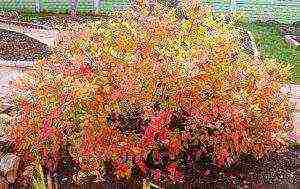
note! Despite the nutritional value, mullein cannot be added: it contains a lot of nitrogen, which stimulates the formation of young shoots, as a result of which the plant wastes the energy accumulated for wintering. For the same reason, nitrogen-based mineral fertilizers are not used for the autumn feeding of spirea.
Pruning. Such fast-growing shrubs as spirea need to be cut off annually so that the plant blooms luxuriantly and has a decorative look. In addition to the aesthetic component, garden manipulation is an excellent prevention against fungal diseases.
Mulching. Despite the fact that the spirea is endowed with excellent cold resistance for reinsurance, the roots of the shrub, which are located close to the surface, are covered with a layer of peat, leaves or hay.The same mulch is placed on top of bent shoots to protect them from frost.
Shelter. Most varieties of spirea are endowed with high frost resistance: the bushes can withstand a drop in temperature to -35 ..- 50 C. Only species such as Japanese spiraea, white-flowered and nippon suffer from frosts in the middle zone. At the arrival of spring, the owner of such spirits often discovers freezing of the tips or all of the shoots.
Video: caring for spirea, including in the fall and in preparation for winter
Pruning in the fall
It is impossible to grow beautiful flowering bushes on your site without regular pruning. Thanks to the autumn haircut, the spirea acquires a lush crown, which in the next season will be completely covered with bright flowers. In addition, as a result of correct pruning, the plant reacts less painfully to cold weather, which is very important when growing relatively thermophilic varieties of spirea.
Why crop
Having planted a lush bush for the first time on their site, many doubt whether it is necessary to cut it, fearing to harm the plant or spoil its appearance. Spirea needs pruning for the following reasons:
- Cutting improves the air permeability of the bush, making the plant more resistant to fungal diseases and insect pests.
- Removing dried, deformed and too protruding shoots from the crown improves decorativeness.
- Pruning old branches stimulates the plant to form new growth.
- Due to the shortening of the shoots, the bush blooms more abundantly and becomes more magnificent due to the active growth of side shoots.
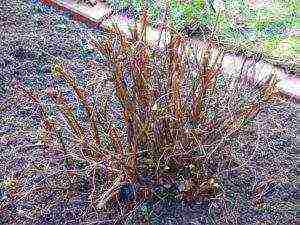
Thus, pruning is an indispensable part of the normal growth of a flowering shrub. And if the pruning was done according to all the rules, there is no need to worry about the plant at all, since the spirea is endowed with the ability to quickly recover.
When is the best time to prune - in spring or autumn
One part of gardeners transfers pruning before the cold weather to the beginning of spring, thereby saving their time and not injuring the plant before winter, the other is confident that the autumn pruning of spirea increases resistance to adverse conditions and helps to winter.
Despite this division of opinion, manipulation in equal parts is effective both in the spring and in the fall. Therefore, each spirea owner needs to determine the optimal time for pruning, based on the condition of the plant and their own preferences.
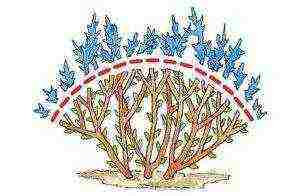
Pruning dates in the fall
In order for the slices to heal before the cold weather sets in, the autumn pruning of the spirea should be carried out no later than 2 weeks before frost. Depending on the weather conditions in different regions, the optimal time for manipulation occurs in September or October.
How to cut correctly - instructions and diagram
The shrub begins to be cut in the second year after planting. Pruning is done in the following order:
- Remove dried, pest-infested and diseased shoots. Broken and damaged branches are cut off to the first living bud.
- In young shoots, the tips are cut off, which did not have time to lignify.
- On late clear shrubs, dried inflorescences are cut off.
- To rejuvenate the plant, 1-2 branches 3-4 years old are cut under a ring and replaced with young ones.
Rejuvenating pruning begins to be carried out on plants older than 4-5 years. The aging of the plant is evidenced by a large number of old shoots and the absence of young shoots. In order to bring the beloved bush back to life, all shoots are cut at a height of 30 cm from the ground. As a result of pruning, spirea quickly replaces the lost branches with young ones, on which many flower buds are formed.

If the bush is not only very old, but also badly damaged, deep pruning is used: all branches of the spirea are completely cut off. After carrying out such a manipulation, hemp should not remain, otherwise lifeless thin shoots will grow from the buds, and the bush will lose its beauty.
Video: autumn pruning of Japanese spirea
Worth knowing! Spirea lives for about 15-20 years, and if after rejuvenating pruning the bush does not form strong shoots, it's time to replace it with a new one.
Separately, it is worth mentioning the cultivation of the hedge. In order for group plantings to have a well-groomed look, you need to trim the spireas annually. During pruning, hedges give or maintain the desired shape by shortening the bulging shoots from the total green mass. The maximum length of the cut branches should not exceed one third of the length of the annual growth. In plants that have reached the age of 4-5 years, the shoots can be shortened by half of the growth.
Video: how to trim a spirea
Leaving after pruning, feeding and fertilizing
Having completed the pruning, the area adjacent to the spire is removed from the debris. And then the cut bush is watered abundantly and complex fertilizers are applied with a large amount of phosphorus and potassium.
Shelter for the winter
Warming plants in the garden before winter is by far the most important manipulation, the quality of which can preserve the plant or negate all other preparatory work and destroy it. For the construction of a winter shelter, no special materials and skills are required, all that is needed is the materials at hand and half an hour of free time.
Do I need to shelter for the winter
The feasibility of sheltering a spirea for the winter depends on the characteristics of the variety and the weather conditions of the region. In our country, under the condition of a snowy winter, medium, low, gray, oak-leaved, three-lobed spiraea can do without shelter: representatives of these species survive until spring when temperatures drop down to -50 C.
Shelter is especially important for recently planted spirea bushes, which have not yet managed to form a powerful root system, due to which they are strongly influenced by freezing temperatures, regardless of the variety.
How to properly cover for the winter
During the shelter of the spirea for the winter, it is important to follow the established rules so that the bush feels comfortable during the winter and does not come out.
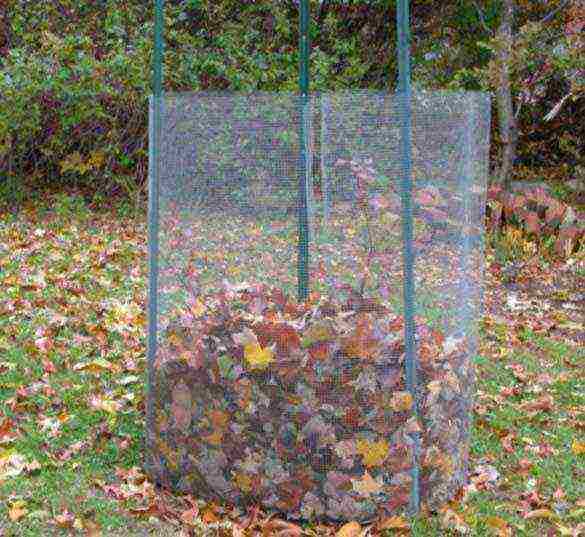
To protect a lush flowering shrub from the cold, you need to do the following:
- Shoots are collected in a loose bundle and tied with a rope.
- The trunk circle is covered with a 10 cm layer of dry mulching material: peat, straw or foliage.
- The prepared branches are carefully bent to the ground and fixed with a metal hook.
- A layer of dry foliage 10-15 cm thick is laid on top of the bush and applied with several branches so that the wind does not blow the mulch.
In winter, the shelter is supplemented with snow, throwing in thermal insulation material from other parts of the garden. Such a simple shelter will protect the shoots and the plant itself from freezing.
What are the features of preparing for winter in different regions
The climate of different regions of Russia is very different from each other, therefore, in order for the wintering to end successfully during the preparatory work, it is necessary to take into account the weather conditions.
In the Central lane and the Moscow region
If it is a snowy winter, the upper part of an adult shrub is not covered, since the snow cover will protect the branches of the spirea from unexpected severe frosts. To protect the root system, the spirea's near-stem circle is covered with a 10 cm layer of mulch, which is applied with tops or branches.
In the Volga region
The plant is insulated in the same way as in the Middle Lane. The only thing I would like to remind you about is the need to carefully cover young seedlings, regardless of the growing region.
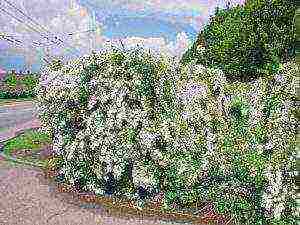
In the Urals and Siberia
In the northern regions, only winter-hardy varieties are grown that are capable of reinsurance during six months of cold weather. Pruning in the Urals and Siberia is carried out in the spring, since the large-scale removal of branches can take a lot of strength from the plant, and it will not be able to survive the winter. The shrubs are covered in the same way as in other regions. The only difference is that the thickness of the mulch layer increases to 20 cm.
Typical mistakes of care in the fall and preparation for winter
Doubts or poor knowledge of the technology for growing spirea are the main reasons for making mistakes that adversely affect the bush. The following mistakes when caring for spirea in autumn and preparing for winter will help to avoid repeating wrong actions:
- In the hope of preventing freezing of the ground, spirea is often and abundantly watered. Due to excessive watering, the rhizome rots and the bush dies.
- Nitrogen-based mineral fertilizers are applied.
- Pruning deadlines are not met. As a result of cutting too late, the plant does not have time to recover by winter.
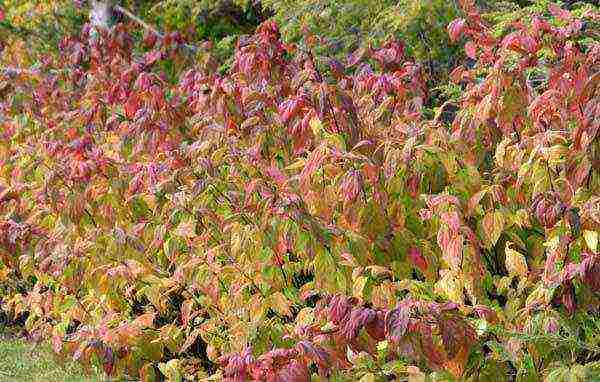
Having devoted a little time to spirea before winter, one can safely expect the most beautiful spectacle in the form of abundant bright flowering. The main condition is that all components of autumn care must be done correctly.
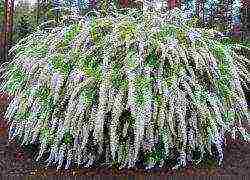
There is no better way to make a plot cute than to plant a spirea there - an unpretentious and charming shrub during the flowering period. Caring for this plant is simple enough not to cause any particular difficulties even for a gardener with minimal experience. The only thing that can confuse a beginner is the preparation of the spirea for winter: how to insulate and preserve, whether pruning is needed, etc. You can find the answers to them in our article.
How to prepare spirea for winter?
The good news for all new spirea owners will be the fact that, due to the high level of winter hardiness, most species of this shrub do not require any special preparation for wintering. As specially conducted tests have shown, critical for almost all spirits by frost is the temperature drop to -50 degrees. Less weak frosts do not cause any harm to this plant. But if winter promises to be frosty and snowless, you should still carry out some measures to prepare the spirea for winter:
- After the end of flowering, carry out sanitary pruning of the shrub, while cutting out all the weak, diseased and dead shoots. But it is better to leave the molding pruning of the bush until spring, so as not to weaken the plant before the winter period.
- After the end of the leaf fall, loosen the ground around the bush, water it abundantly and insulate the spirea for the winter with a layer of fallen leaves, peat or sawdust to a height of at least 15-20 cm.This shelter will allow the bush to preserve the root system, increase its frost resistance and protect it from freezing the tips of the branches ... Those branch tips that are still frozen are removed during spring molding pruning. When caring for young spirea bushes, it is better to play it safe and organize such insulation, even if they do not promise severe frosts.
Among the ornamental shrubs, spirea occupies a special place. She is surprisingly unpretentious and easily forgives the gardener even the most unobtrusive care. A wide variety of shapes and types allows you to choose the plant to decorate the site that will best fit into the surrounding landscape. Planting and caring for a spirea is not difficult, even a novice gardener can handle it.
Spirea: types and varieties
The genus spirea belongs to the pink family and is quite numerous, it includes more than 70 species. The distribution area of this deciduous shrub is wide. It can be found in the northern hemisphere in most climatic zones. Spirea rarely has single flowers, most often they are collected in a corymbose inflorescence, sometimes in a panicle. The color of flowers depends on the flowering time of the species. Plants blooming in spring have white flowers that bloom on last year's shoots, in species blooming in summer pink-crimson gamut prevails, flowers are located on annual growths.
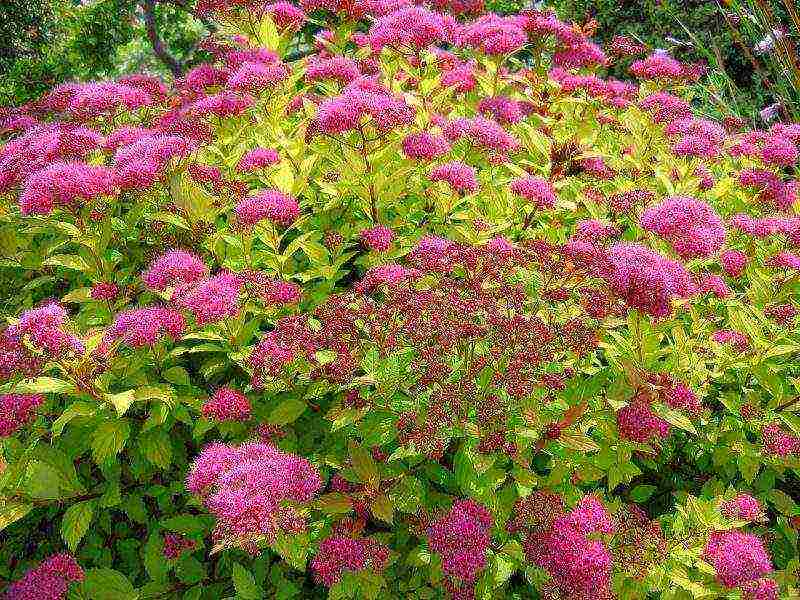
The most common types.
- Medium spirea - an inhabitant of Siberian and Far Eastern forests, a tall shrub - above 2 m with white corymbose flowers that open in May and do not fall for 3 weeks, frost-resistant and drought-resistant, used in landscaping, suitable for northern regions.
- Spiraea birch-leaved - grows in Siberia, from 1 to 2 m in height, white flowers are collected in huge shields - up to 10 cm in diameter, blooms at the end of May and blooms throughout June.
- Spirea crenate - has been used in landscaping for 200 years, there are cultural hybrid varieties. In nature, it is a low shrub, only up to 1 m, blooming at the end of May. Quite large flowers are collected in corymbose inflorescences, due to the large number of long yellow stamens, it seems that they have a golden hue. This type of spirea is drought-resistant and frost-hardy, can be used to strengthen floating soils.
- Spirea St. John's wort is a shrub up to 1 m high, flowering - May-June, white flowers, is used to obtain new forms of the plant.
- Gray spirea - the result of crossing the previous species and whitish-gray spirea, has highly decorative varieties that bloom in spring. The most beloved variety of this species by flower growers is Spirea Grefsheim. The shoots of the tall bush bend towards the ground under the weight of flowers that completely cover the bush. The flowering is so abundant that the leaves are almost invisible.
- Spiraea is oak-leaved - blooms with umbrella-shaped inflorescences of white flowers with a large number of protruding stamens for 25 days, flowering occurs in May-June. The species is used in culture, it tolerates a haircut well.
- Spirea Nipponskaya came to us from Japan - this highly ornamental shrub 1-2 m high is decorated with yellowish-white inflorescence shields that appear in June. It does not differ in frost resistance; in severe winters, the tops of the shoots freeze slightly, but quickly recover. The most famous variety is Snowmound. A huge number of flowers on a bush up to 1.5 m high makes it very decorative at the time of flowering. The width of the bush is 2 times the height.
- No less decorative and spirea Wangutta is a hybrid species that blooms very profusely in June-July with white flowers collected in shields. The bush has an average height and can freeze slightly in frosty winters.
- Japanese spirea is quite thermophilic, but due to the low height of the bush - up to 1 m it winters without loss, covered with snow. The most interesting varieties are Little Princesses and Shirobana. Little princesses - a bush up to 80 cm high and up to 1.2 m wide blooms very profusely in June-July with pink flowers collected in medium-sized shields, grows slowly. Shirobana is a bush up to 0.8 m high and up to 0.6 m wide, blooms in mid-summer. Flowers in corymbose inflorescences have three colors - white, pink and crimson, if you cut off faded inflorescences, new ones will decorate the bush for another month.
- The adorable spirea stands out among other species by double flowering: in June on last year's shoots and in July and August on newly regrown ones. Flowers are collected in complex shields, can be white or pale pink. The species does not differ in frost resistance - up to -18 degrees, so in the middle lane it hibernates under cover.
- Spirea Bumald is a decorative hybrid species, it also has a yellow-leaved form. The bush is low - up to 0.8 m in width and height. It blooms for more than 3 months with bright pink flowers in large shields. The most famous variety is Antoni Vaterer.
- Willow spirea grows wild in Siberia. The tall bush blooms in July and August with bright pink flowers collected in pyramidal panicles.
- Spirea Douglas grows above 2 m. In the second half of summer, it is decorated with pink flowers, collected in a paniculate inflorescence.
- When crossing the previous species and spirea willow leaf we got Billard's spirea. A tall, frost-resistant shrub blooms in the second half of summer and is decorated with large pink paniculate inflorescences until the very frosts.
- The hybrid lilac spirea also blooms for a long time, only paniculate inflorescences, in accordance with the name, have a lilac-pink color. The bush can grow up to 2 m.
Spirea: features of cultivation
Spireas are unpretentious, but with proper careful care they give abundant flowering. Different flowering times dictate different pruning times.Some species and varieties have special soil and maintenance preferences. Most spirits prefer humus-rich, but not heavy soil without stagnant water, but they will feel good even on not very fertile soil. To keep the roots from getting wet, they need drainage. But before you plant a plant, you need to propagate it.
Shrub propagation
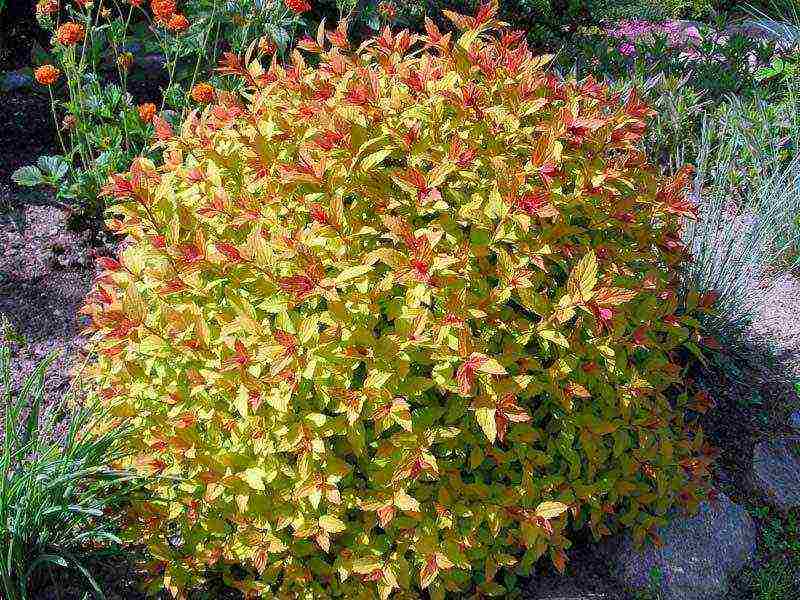
Spirea is very easy to propagate. Some species produce root shoots that can be transplanted. Parts of a divided bush take root well. Flexible shoots allow cuttings to be rooted. For propagation of all species, cuttings can be used, and for non-hybrid forms and varieties, seeds can also be sown.
Cuttings
When rooting the cuttings, you will get an exact copy of the parent plant. Green cuttings in early flowering varieties are cut in early June, and in late flowering varieties at the end of the month. For already lignified cuttings, the best rooting time is autumn, September or October.
- The annual green shoot is cut and cut into pieces with 5-6 leaves.
- Remove the bottom pair of leaves, cut the rest by half.
- The lower cut is placed in a vessel with an epin solution for 12 hours.
- It is treated with a powdery root stimulant.
- They are planted in a container with loose soil, sprinkled with a layer of sand at an angle of about 40 degrees to stimulate root formation.
- Cover with foil or glass jar and put in lacy shade under the trees.
- They moisten the soil in the cuttings, preventing it from drying out, and the cuttings themselves are sprayed several times a day.
- In autumn, the container is dropped into the soil, mulched with fallen leaves and covered with a wooden box.
- In the spring, the shelter is removed. After the appearance of young shoots, the plants are planted in the garden in a permanent place.
Seed propagation
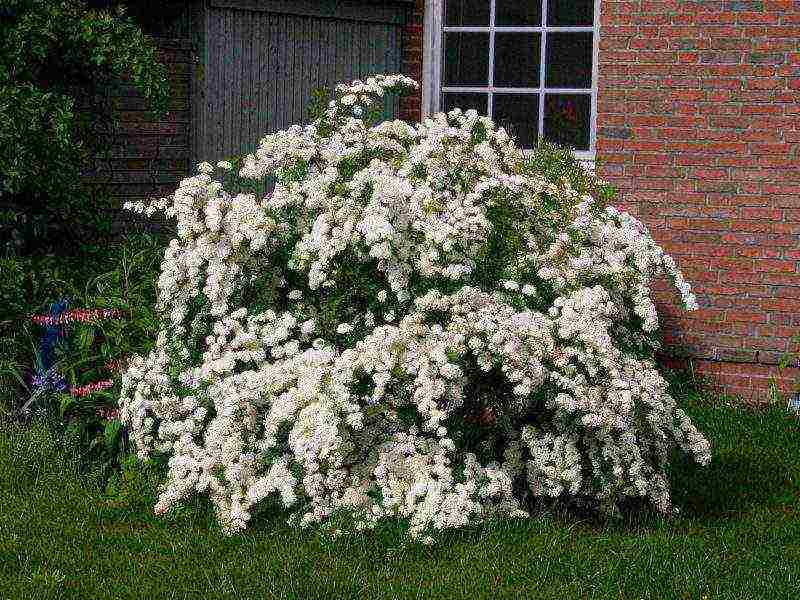
In non-hybrid varieties and species, seed germination reaches 80%. Collect them when the boxes turn brown, but have not yet opened. Dose in the room for 2 weeks. You can sow both before winter and in spring. Seeds do not require stratification. Seedlings dive when 2 true leaves are formed. Further care: watering as needed, 2 dressings with full mineral fertilizer. In the fall, seedlings are planted in a seedling bed, and next year in a permanent place. They begin to bloom for 3 years.
Landing in open ground
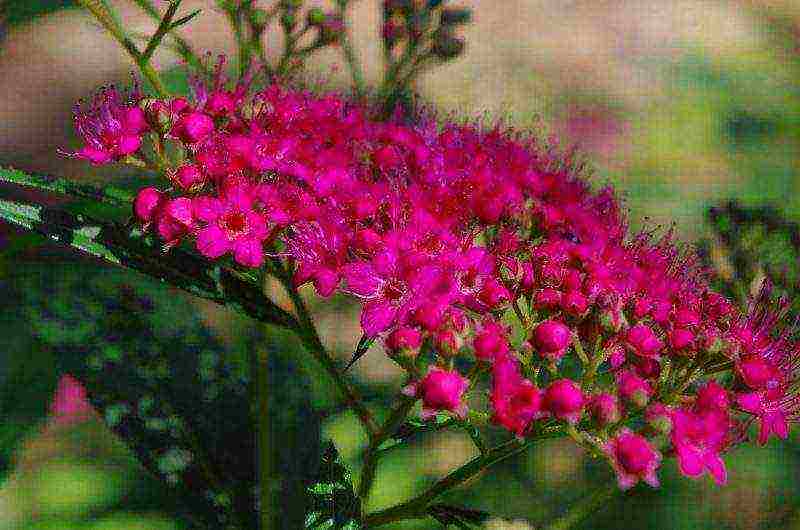
Proper planting is the key to abundant flowering and plant health. It is very important to maintain the optimal distance between the plants in order to provide them with the necessary nutritional area. When laying a hedge, it is enough to plant spireas 30 cm apart, for a normal planting the distance should be greater, since the bushes grow strongly in width: for tall varieties - about 1 m, for undersized varieties - 0.8 m.
The choice of planting material
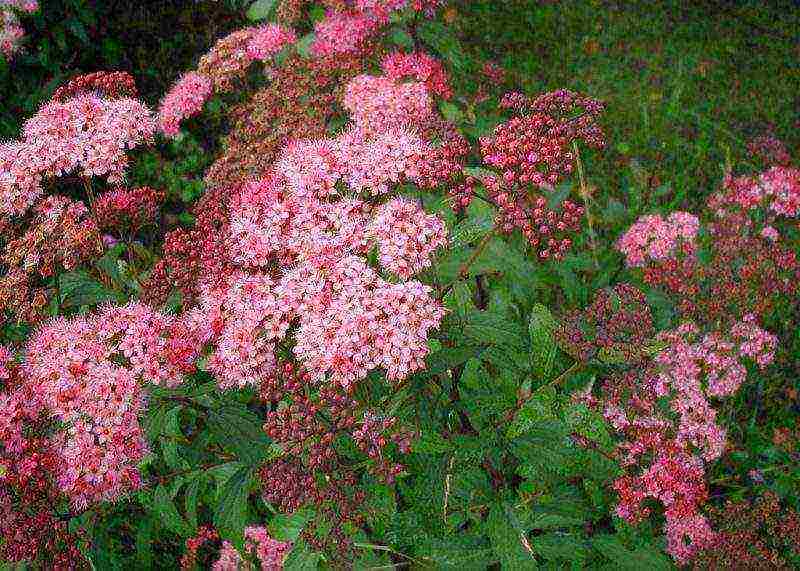
Now on sale there are many varieties and hybrids of spirea. The choice of a plant depends, first of all, on what place the spirea will occupy in the landscape design of a particular site. A hedge will require many plants of the same species, it is better if they are tall. As a tapeworm, you can plant an openwork bush with long flowering. On an alpine slide, undersized compact varieties will be appropriate. But whichever variety you choose, the plant should have a developed and healthy root system, consisting of 3 taproots and a well-developed lobe covered with a clay mash. With spring planting, not swollen buds, and with autumn planting, already flown leaves. It is best to choose a container-grown seedling that can be planted throughout the growing season.
How and when to plant?
Spirea is planted in pre-dug holes. Their size should be slightly larger than the root system of the plant. Usually the depth is about 70 cm, 20 of which falls on the drainage of expanded clay or brick fragments. The diameter of the hole is determined by the size of the roots.
Landing Algorithm:
- a plant is placed on a mound of earth poured in a hole, spreading the roots;
- fill up the earth, taking into account that the root collar is strictly at the level of the soil;
- watered in the planting circle using 2 to 3 buckets of water;
- mulch the soil around the bush with a layer of peat 7 cm thick.
Planting time depends on the selected variety: late flowering plants are planted in spring, early flowering ones in autumn, but no later than 3-4 weeks before the onset of frost.
Soil preparation and site
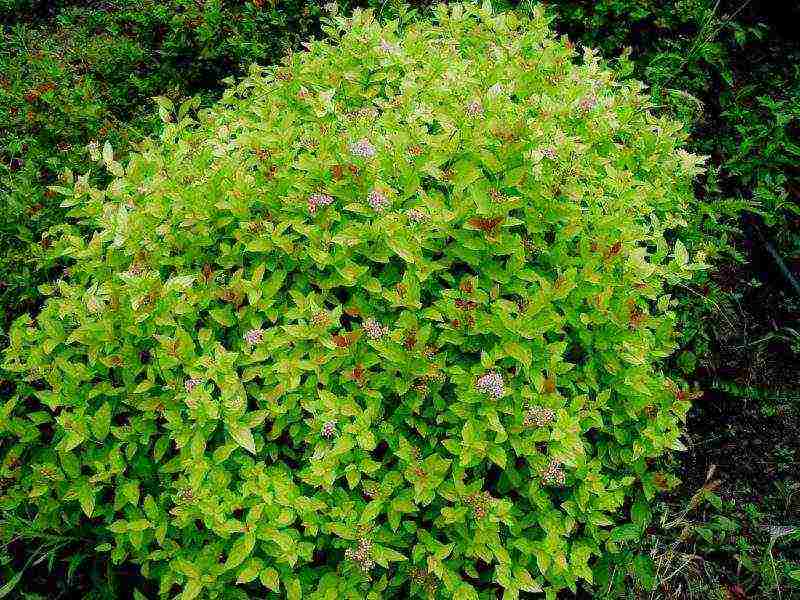
The planting site should be well lit by the sun, a little shading is allowed during the day. It must be remembered that in the shade of the spirea it blooms badly.
This plant is undemanding to the soil. The preferred soil for spirea is light sod or leafy, with a neutral or slightly acidic soil reaction. Heavy clay soils are improved by adding sand and peat, a little clay should be added to light sandy soils. From fertilizers, you can add Art. tablespoons of long-acting ABA fertilizer for each bush. This amount will be enough for the plant for several years.
The nuances of planting in spring, autumn
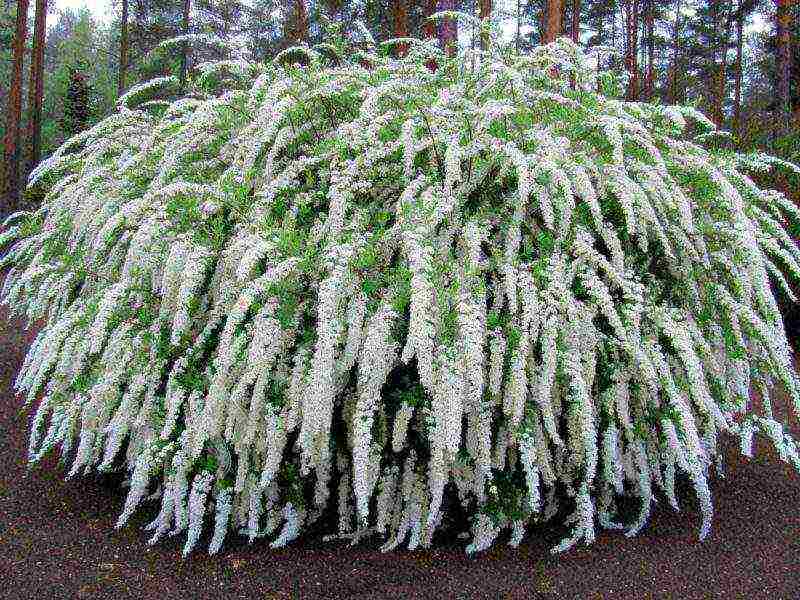
If the variety blooms in summer, it is better to plant it in spring, early flowering varieties are planted in autumn, but so that the bushes take root before the onset of frost. In both cases, the plants must be dormant. In the spring, the buds should not swell yet, and in the fall the leaf fall should already end.
Outdoor care for spirea
An unpretentious plant does not require special care measures, but top dressing and watering made on time will provide it with maximum decorative effect.
How to water properly?
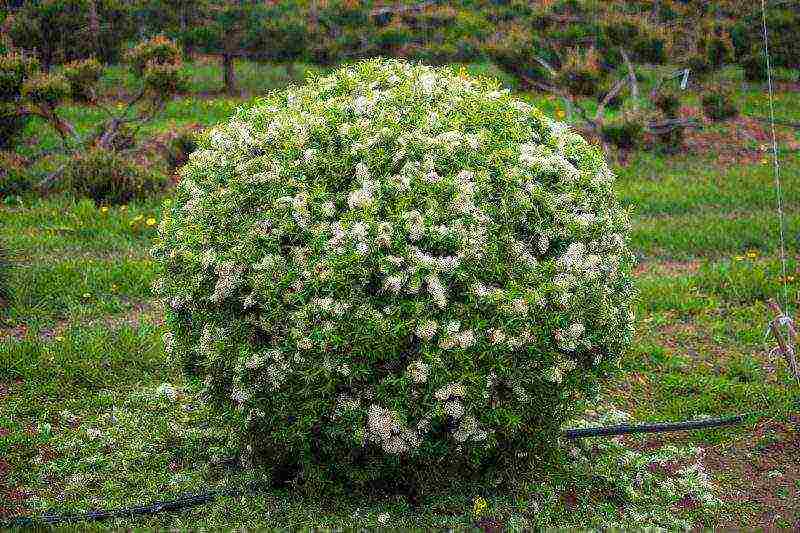
Spirea is a drought-resistant plant, but in extreme heat and in the absence of rain for a long time, it must be watered. This is especially true for recently planted bushes. For an adult plant, the watering rate is 1.5 buckets per bush. For undersized species and varieties, one bucket is enough. Watering is sufficient once every 2 weeks, well soaking the root layer.
Fertilization and feeding
In order for the spireas to grow and bloom well, they should be fed regularly.
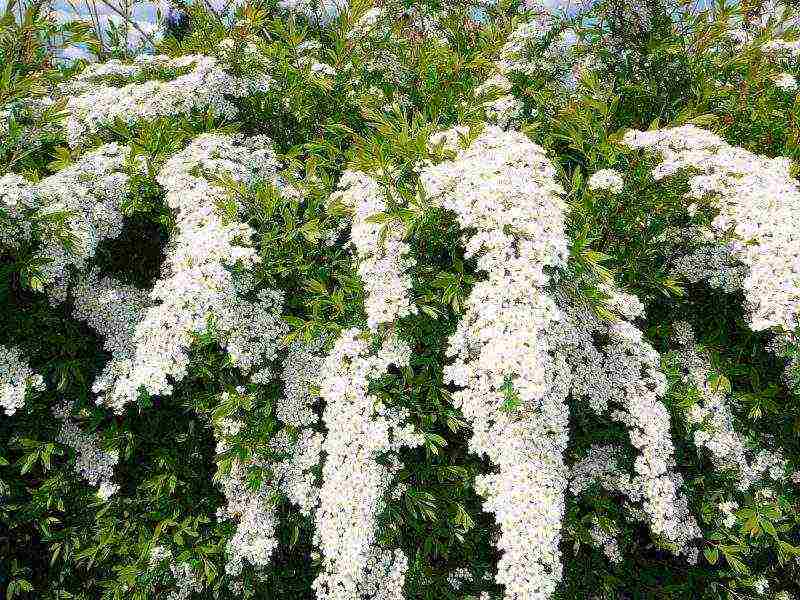
You can choose the following power plan:
- in spring, nitrogen mineral or organic fertilizer; for early flowering varieties, additional feeding with complete mineral fertilizer with microelements is needed;
- in June, plants are fed with full mineral fertilizer;
- at the end of August, fertilizing with phosphorus and potassium salts is needed so that the spireas are better prepared for winter.
At the end of summer, spireas cannot be fed with any fertilizers containing nitrogen, this can provoke the growth of new shoots that do not have time to ripen and freeze in winter.
All dressings can be applied both dry and liquid, combining them with watering. The next day, the soil around the plant must be loosened.
Spirea pruning
It is held on several dates, depending on the destination.
- Spring pruning is sanitary. Only dry and frost-damaged shoots are removed.
- Formative. Spireas blooming in the summer on the shoots of the current year are pruned in the spring immediately after the snow melts, combining formative pruning with sanitary pruning. Thin branches thickening the bush are removed - they will not give a good flowering. Different types of spirea have their own subtleties in pruning. Pruning of Douglas and Boomald spirits begins only in the fourth year of life. Miniature varieties not exceeding 40 cm in height are cut into 2 buds. Cut out shoots with foliage that does not match the color of the variety. After flowering, the seed pods are removed, if there is no need for seeds - this contributes to the re-blooming of the inflorescences. It is enough to cut off a third of the shoot. The green hedge is trimmed to give the desired shape. Spring-flowering spireas form after flowering, cutting off shoots at the level of a strong young growth. The crown of the bush should be symmetrical.
- Anti-aging pruning. It is carried out in adult bushes, starting from the 7th year of life. All old shoots are removed, leaving no more than 5-7 young ones, while maintaining the symmetry of the bush. This pruning is best done in several stages, so as not to greatly weaken the bush.
Preparing for winter
The first wintering at a recently planted bush is a serious test. But adult plants, despite the frost resistance of most varieties, and species also need preparation for winter. For many of them, it is enough to feed the plants in August with potash and phosphorus fertilizers, to carry out moisture-charging irrigation after leaf fall and to mulch the trunk circle with humus.
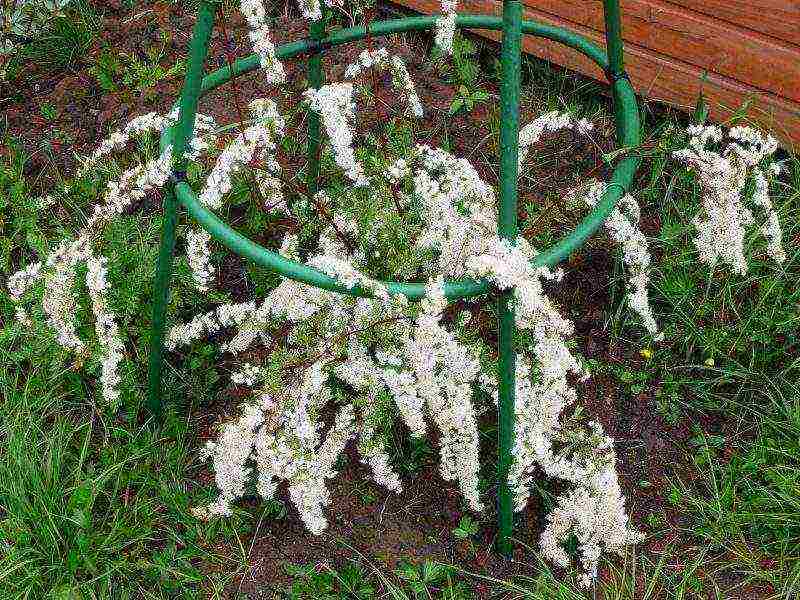
For less frost-resistant varieties, you will have to build a shelter:
- tie the branches into a bunch;
- bend the beam to the ground, fixing it with special fasteners;
- fall asleep with dry leaves;
- additionally throw in snow.
Plant diseases and pests
Spiraea rarely suffers from disease, but in a damp summer it can be damaged by powdery mildew and gray mold. To eliminate them, copper-containing fungicides, Fitosporin, colloidal sulfur are used.
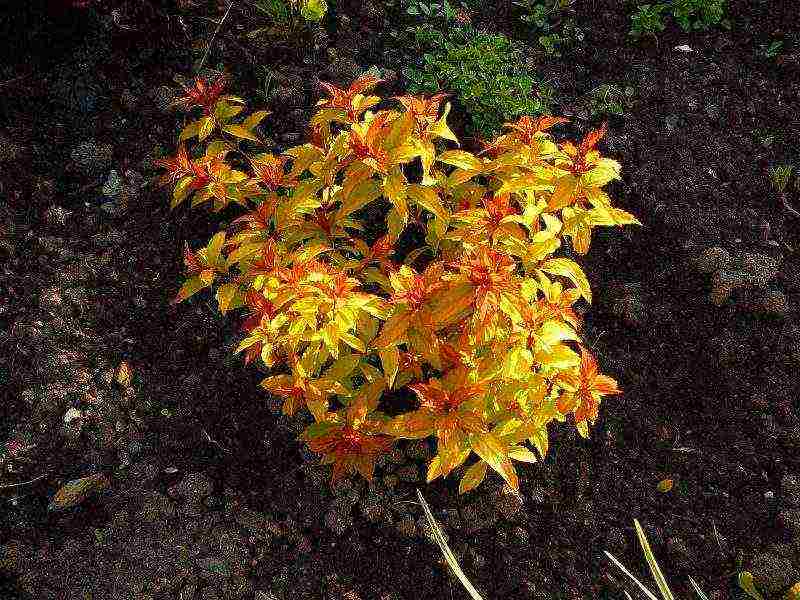
Among the most common pests are aphids, blue meadow sawfly, whitefly and spider mites. Insecticides are effective against the first three: Fitoverm, Actellik. Insectoacaricides are suitable against the tick: Metaphos.
The nuances of growing in Siberia, in the Urals, in the Moscow region
Almost all varieties and types of spirea are suitable for growing in central Russia. Shrubs such as Japanese Spirea and Nippon Spirea need additional winter shelter.
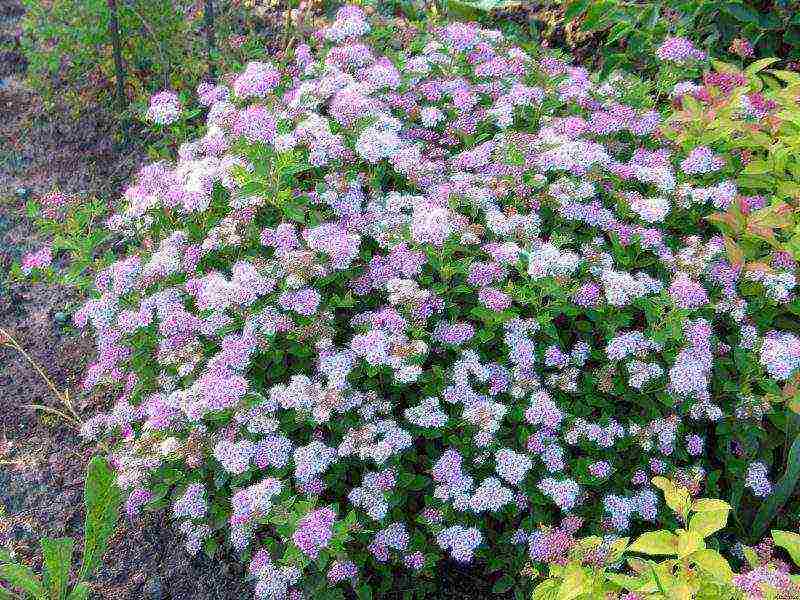
In the Urals, the climate is more severe. In its southern part, almost all types of spirits will grow well. In the middle lane and, especially in the north, frost-resistant shrubs should be preferred. The same can be said about spirea in Siberia. Only undersized varieties are able to overwinter under the snow without much loss. If medium and tall plants are not covered, then constant frosting in winter is guaranteed to them, decorativeness and abundant flowering cannot be achieved in such conditions.
Correctly selected varieties of spirea are able to create a flowering conveyor throughout the growing season and will be a real decoration of any garden.
Spirea attracts attention with beautiful, curved branches, hence its Latin name (from the Greek word "bend"). In Russia, this plant has been known for a long time under the name meadowsweet.
There is a mention of him in the epic epic of the Novgorod merchant Sadko. Dahl's explanatory dictionary speaks of the practical use of shrubs, from strong and thin rods of which rods and whips were made. And at the end of the 16th century, the plant began to be used as an ornamental shrub.
Spirea plant description
Spirea is widespread. It grows even on the Kola Peninsula. Available in the collection of the Polar-Alpine Botanical Garden.
It is a deciduous shrub with a maximum height of two meters, the shape is varied and can be in the form of a ball, hemisphere, pyramid, cascade, etc., is of interest to landscape designers its long flowering. Depending on the species, the flowers can be located either at the ends of the branches or cover them completely
Based on the flowering time, spirea is classified into two groups:
- spring blooming
- summer blooming
In spring-flowering spirits, flowers are only white, appear on last year's shoots. In addition to white, summer blooms can have various shades of pink and they bloom on the shoots of the current year.
Depending on which group the plant belongs to and it is determined when to plant it and how to care for it.
Spirea how to plant and care
Planting time is determined depending on the species. This is mainly autumn (before the end of leaf fall), but there are varieties that can be planted in early spring. The place for the spirea needs to be determined sunny. The shrub grows better on fertile soils.
The plant will make an excellent composition with other shrubs, and also make beautiful hedges from it. Spirea looks spectacular on the banks of an artificial reservoir. Spirea is good honey plant... Therefore, in an area where several bushes grow, hives can be kept.
It is better to prepare a hole for planting a shrub in a couple of days. The depth and width are determined according to the size of the root system. Before planting, the seedling must be soaked in water with the addition of a growth stimulant. Examine the roots carefully, cutting out rotten and dry ones. It is necessary to determine exactly where the root collar is located in the plant, so as not to deepen it when planting.
Fill the pit with soil mixture (earth, peat, sand), if the soil is clayey, arrange drainage. Place the bush in a hole, focusing on the level of the root collar, gently straighten the roots, covering them with earth. Compact the soil around the bush, water and mulch.
Spirea how to cut
Spirea care is an easy and pleasant experience, as the bush is unpretentious. Pruning is the main thing to learn to do with spirea. It can be given any geometric shapes: a ball, pyramid, triangle. Pruning time can be different and depend on the purpose of using the plant in landscaping.
After pruning, it is good to add organic and mineral fertilizers. To achieve a more lush flowering in the spring, it is recommended to feed the plant with a special complex fertilizer.
The plant is not at all demanding for watering and needs it only in dry summer.
Preparing spirea for winter
Spirea is a frost-resistant plant. An adult plant tolerates even severe frosts. But if the winter is expected to be harsh and with little snow, it is better to carry out preparatory measures in the fall. To do this, spud the root collar of the bush at the level of fifteen to twenty centimeters with earth, peat, sawdust. To insulate the roots, cover the ground around the spirea with dry leaves. You can also insulate, we love modern covering material.
Diseases and pests of spirea
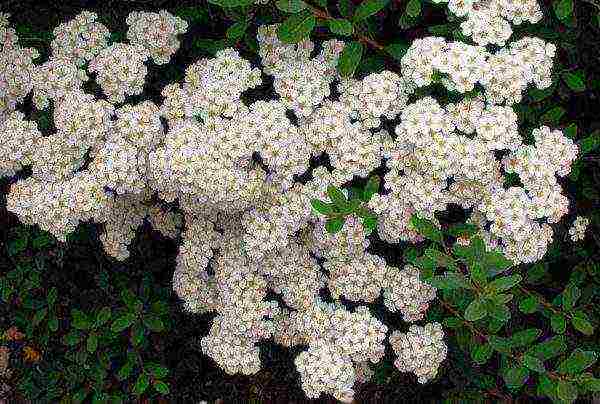
Spirea is disease resistant and pests... It is affected by aphids, rosaceous leafworm, rosaceous miner. Most dangerous for the plant spider mite... To prevent its appearance in dry summer, it is necessary to spray the plant with water every three days.
How to propagate spirea
For reproduction of spirea, the seed and vegetative method are used.
Vegetative propagation is carried out by dividing the bush, cuttings and layering.
When the gardener needs to receive a large amount of planting material, it is better to use cuttings.
In varieties blooming in spring, cuttings are cut in the first decade of June, in summer flowering in late July - early June
For cuttings, suitable young healthy shoots one year old.
To propagate the spirea by layering, you need to pin down and cover with earth a young healthy shoot and moisturize it all summer.
Well-developed three to four year old bushes are suitable for reproduction by dividing the bush.
And finally, an interesting fact about this ornamental shrub. In 1839, salicylic acid acetate or the well-known drug aspirin was obtained from the plant.
SHARE INTERESTING INFORMATION WITH YOUR FRIENDS!
READ ALSO


